Walls Tell Stories – Complete Guide for CBSE Class 5 EVS Chapter 10
Welcome to iPrep, your Learning Super App.
Our learning resources for the chapter Walls Tell Stories! for Class 5 EVS are designed to ensure you grasp this concept with clarity and perfection. Whether studying for an upcoming exam or strengthening your concepts, our engaging animated videos, practice questions and notes offer you the best integrated learning with interesting explanations and examples.
Walls Tell Stories: Exploring History Through Forts and Ancient Architecture
Welcome to Golconda Fort!
Imagine visiting a massive fort with high walls, huge gates, secret tunnels, and beautiful carvings! In this chapter, we’ll join Shailja, Shreedhar, Kalyani, and their didi on their visit to Golconda Fort in Hyderabad. They discover fascinating stories hidden in the fort’s walls and learn about the people who lived there long ago.
Discovering the Mighty Golconda Fort
The children are amazed as they reach the fort. The fort walls are thick, tall, and topped with sharp iron spikes. They even see a small door within the larger gate – a clever way to protect the fort from enemies!

The grand entrance gate of Golconda Fort.
Questions to Think About: Walls Tell Stories!
- Why do you think the walls were built so thick?
- What do you think the small door inside the big gate was used for?
Why Are There Bastions?
As they walk along the walls, didi shows them the bastions, which are round structures that stick out from the wall. These bastions allowed soldiers to look in every direction to keep the fort safe. Golconda Fort has 87 bastions, making it very well protected!
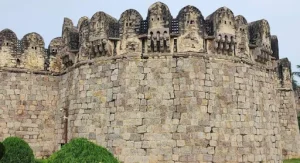
The bastion at Golconda Fort used for surveillance.
Think and Reflect:
- How do you think soldiers used these bastions during an attack?
- What would be the difference if the wall was straight instead of round?
Inside the Fort: Palaces, Gardens, and More
Inside Golconda Fort, the children find maps showing beautiful palaces, gardens, wells, and even factories! Long ago, the fort was like a small town where many people, including farmers, workers, and guards, lived alongside the king and his family.

The inner structures of Golconda Fort, where people once lived and worked.
Imagine and Draw: Walls Tell Stories
- Can you imagine what life would be like living inside a fort? Draw what you think the fort’s town looked like.
Discussion Questions:
- Why do you think the fort had gardens and wells inside it?
- What would people need in a fort to live comfortably for a long time?
Amazing Architecture: Carvings and Fountains
The fort has intricate carvings and beautiful fountains. The children wonder how these fountains worked without electricity. Didi explains that the people back then used clever engineering to lift water to high places, filling the tanks and fountains.
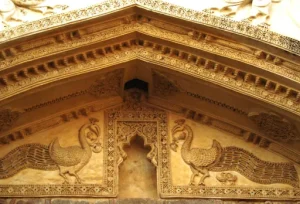
Detailed carvings on the walls of Golconda Fort.
Think About It: Walls Tell Stories
- How do you think they moved water to higher levels in the fort without machines?
- What kind of tools do you think were used to make such fine carvings?
Exploring Directions and Maps: Finding Places Inside the Fort
The children use a map to find different places inside the fort, like the Bodli Darwaza and Katora Hauz. By looking at the map, they learn how to find directions like north, south, east, and west.
Activity: Find Directions!
- Use a map to find different directions in your area. Which side is north, south, east, and west?
Why Were Forts Attacked? The Story of Aurangzeb’s Army 🐘💥
In the past, kings often tried to conquer neighbouring kingdoms by forming alliances, marrying into other families, or even attacking. Aurangzeb’s army once tried to capture Golconda Fort, but despite their powerful cannons, they couldn’t break through the fort’s walls.
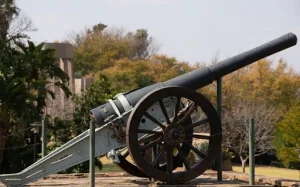
Cannons like these were used to attack forts in ancient times.
Questions to Discuss:
- Why do you think kings wanted to capture other forts?
- Can you imagine how defending a fort from an enemy would feel?
Messages Without Phones! How Did People Communicate? 📣
Didi took the children to Fateh Darwaza (Victory Gate). When she spoke from there, her voice could be heard clearly inside the king’s palace, even though it was far away! This special design helped people send messages without shouting or using phones.
Fun Experiment:
- Try whispering across a long distance with a friend and see if they can hear you. Does your voice travel far in certain areas?
Discussion Question:
- How would you send a message without using a phone or the internet?
Ancient Water Systems: Lifting Water Without Electricity
The children see a picture of a machine that used bullocks to pull water up from a well. A chain of pots attached to a wheel lifted water from the well and poured it into a channel. The people of Golconda were very creative in finding ways to transport water without using electricity!
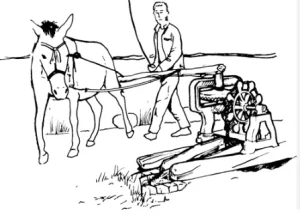
A water lifting system using animals and gears.
Try This!
- Can you think of ways to transport water without using electricity? Draw your own idea!
Respecting Heritage: Why We Should Protect Monuments
As they explore the fort, the children notice that some people have scratched their names on the walls. This makes them sad because these walls have seen centuries of history. Didi reminds them that forts and old buildings are a part of our heritage and should be respected.
Questions to Reflect: Walls Tell Stories!
- Why is it important to protect old buildings and forts?
- How can we take care of historical places during visits?
The Museum Visit: Learning From Ancient Artifacts
After exploring Golconda Fort, the children visit a museum in Hyderabad. They see ancient pots, jewelry, swords, and other items that tell stories about life hundreds of years ago. Didi explains that museums help us understand how people lived in the past.
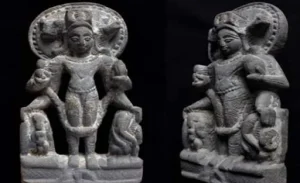
Ancient artifacts found in forts and old buildings.
Activity: Create Your Own Museum
- Collect old items from home, like coins, jewelry, or pictures, and create a mini-museum. Write a story about each item.
What We’ve Learned: Walls Tell Stories
In “Walls Tell Stories”, we learned:
- Why forts like Golconda were built with thick walls, bastions, and water systems.
- How people in the past communicated and lived without modern technology.
- The importance of respecting historical places and learning from our past.
Final Reflection:
- Imagine you’re living in an ancient fort. What would your daily life look like?
- How would you stay safe, get water, and send messages?
To find more such learning resources for class 5, check out the iPrep app.
To read the NCERT chapter Walls Tell Stories! click here.
Practice questions on Chapter 10 - Wall Tell Stories
Get your free Chapter 10 - Wall Tell Stories practice quiz of 20+ questions & detailed solutions
Practice Now








